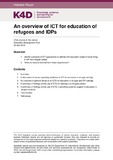| dc.contributor.author | Joynes, Chris | |
| dc.contributor.author | James, Zoe | |
| dc.date.accessioned | 2019-01-08T11:48:10Z | |
| dc.date.available | 2019-01-08T11:48:10Z | |
| dc.date.issued | 2018-11-20 | |
| dc.identifier.citation | Joynes, C. & James, Z. (2018). An overview of ICT for education of refugees and IDPs. K4D Helpdesk Report. Brighton, UK: Institute of Development Studies | en |
| dc.identifier.uri | https://opendocs.ids.ac.uk/opendocs/handle/20.500.12413/14247 | |
| dc.description.abstract | This rapid review examined examples of ICT approaches to address the education needs of those living in IDP and refugee camps and lessons learned from these experiences. Although ICT is considered a good system to fulfil the education needs within refugee settings, many studies conclude that access to ICTs in schools or at home is not sufficient to improve learning outcomes. It is due to the role of a mentor or tutor figure is seen as key to productive learner engagement with technology, and the effectiveness of ICT-based education is reliant on appropriate teacher training to ensure successful up-take at the classroom level (Tauson & Stannard 2018: 47, 62; UNESCO 2018: 74; Carlson 2013: 30). Secondly, in terms of content, ICTs for education should provide content that is responsive or adaptable to the learners’ level, is implemented in line with the local curriculum and also is relevant to the learners’ context (Tauson & Stannard 2018: 36-38, 61). Despite this potential for ICTs, there remains a broad lack of evidence related to education in refugee settings (Burde et al. 2015; Tauson & Stannard 2018; World Bank 2016). In particular, more information is needed on pedagogic design, on the effective use of ICTs for learning, on the role of ICTs in ensuring continuity of and linkages between learning in formal and non-formal settings, on the role of ICTs in educational data-gathering, and on the cost-effectiveness of ICT-led interventions (Burde et al 2015; Tausin & Stannard 2018; Carlson 2013). In light of the availability of evidence, some of the studies cited here instead supplement their findings by drawing on observational studies, and on studies on effective ICT usage from learners in non-refugee contexts (Burde et al. 2015; Tauson & Stannard 2018). | en |
| dc.language.iso | en | en |
| dc.publisher | IDS | en |
| dc.relation.ispartofseries | K4D Helpdesk Report;505 | |
| dc.rights.uri | https://www.nationalarchives.gov.uk/doc/open-government-licence/version/3/ | en |
| dc.subject | Education | en |
| dc.subject | Science and Society | en |
| dc.subject | Social Protection | en |
| dc.subject | Technology | en |
| dc.title | An Overview of ICT for Education of Refugees and IDPs | en |
| dc.type | Other | en |
| dc.rights.holder | © DFID - Crown copyright 2018. | en |
| dcterms.dateAccepted | 2018-11-20 | |
| rioxxterms.funder | Department for International Development, UK Government | en |
| rioxxterms.identifier.project | K4D | en |
| rioxxterms.version | VoR | en |
| rioxxterms.funder.project | 238a9fa4-fe4a-4380-996b-995f33607ba0 | en |

